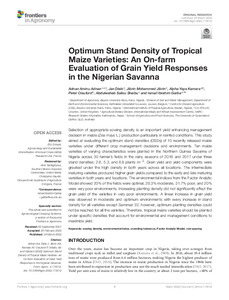| dc.contributor.author | Adnan, A.A. |
| dc.contributor.author | Diels, J. |
| dc.contributor.author | Jibrin, J.M. |
| dc.contributor.author | Kamara, A. |
| dc.contributor.author | Craufurd, P. |
| dc.contributor.author | Shaibu, A.S. |
| dc.contributor.author | Garba, I.I. |
| dc.date.accessioned | 2022-04-06T08:33:34Z |
| dc.date.available | 2022-04-06T08:33:34Z |
| dc.date.issued | 2022 |
| dc.identifier.citation | Adnan, A.A., Diels, J., Jibrin, J.M., Kamara, A., Craufurd, P., Shaibu, A.S. & Garba, I.I. (2022). Optimum stand density of tropical maize varieties: an on-farm evaluation of grain yield responses in the Nigerian Savanna. Frontiers in Agronomy, 4 : 773012, 1-12. |
| dc.identifier.issn | 2673-3218 |
| dc.identifier.uri | https://hdl.handle.net/20.500.12478/7409 |
| dc.description.abstract | Selection of appropriate sowing density is an important yield enhancing management decision in maize (Zea mays L.) production particularly in rainfed conditions. This study aimed at evaluating the optimum stand densities (OSDs) of 10 recently released maize varieties under different crop management decisions and environments. Ten maize varieties of varying characteristics were planted in the Northern Guinea Savanna of Nigeria across 30 farmer’s fields in the rainy seasons of 2016 and 2017 under three stand densities: 2.6, 5.3, and 6.6 plants m−2. Grain yield and yield components were greatest under the high density in both years across all locations. The intermediate maturing varieties produced higher grain yields compared to the early and late maturing varieties in both years and locations. The environmental indices from the Factor Analytic Model showed 20% of the fields were optimal, 28.3% moderate, 31.7% poor, and 20% were very poor environments. Increasing planting density did not significantly affect the grain yield of the varieties in very poor environments. A linear increase in grain yield was observed in moderate and optimum environments with every increase in stand density for all varieties except Sammaz 32, however, optimum planting densities could not be reached for all the varieties. Therefore, tropical maize varieties should be planted under specific densities that account for environmental and management conditions to maximize yield. |
| dc.format.extent | 1-12 |
| dc.language.iso | en |
| dc.subject | Sowing |
| dc.subject | Density |
| dc.subject | Maize |
| dc.subject | Varieties |
| dc.subject | Tolerance |
| dc.subject | Spacing |
| dc.subject | Nigeria |
| dc.title | Optimum stand density of tropical maize varieties: an on-farm evaluation of grain yield responses in the Nigerian Savanna |
| dc.type | Journal Article |
| cg.contributor.crp | Grain Legumes |
| cg.contributor.crp | Maize |
| cg.contributor.affiliation | Bayero University Kano |
| cg.contributor.affiliation | Katholieke Universiteit Leuven |
| cg.contributor.affiliation | International Institute of Tropical Agriculture |
| cg.contributor.affiliation | International Maize and Wheat Improvement Centre |
| cg.contributor.affiliation | University of Queensland |
| cg.coverage.region | Africa |
| cg.coverage.region | West Africa |
| cg.coverage.country | Nigeria |
| cg.coverage.hub | Headquarters and Western Africa Hub |
| cg.researchtheme | Plant Production and Health |
| cg.identifier.bibtexciteid | ADNAN:2022 |
| cg.isijournal | ISI Journal |
| cg.authorship.types | CGIAR and developing country institute |
| cg.iitasubject | Agronomy |
| cg.iitasubject | Food Security |
| cg.iitasubject | Maize |
| cg.iitasubject | Plant Breeding |
| cg.iitasubject | Plant Production |
| cg.journal | Frontiers in Agronomy |
| cg.notes | Open Access Journal; Published online: 24 Mar 2022 |
| cg.accessibilitystatus | Open Access |
| cg.reviewstatus | Peer Review |
| cg.usagerightslicense | Creative Commons Attribution 4.0 (CC BY 0.0) |
| cg.targetaudience | Scientists |
| cg.identifier.doi | https://dx.doi.org/10.3389/fagro.2022.773012 |
| cg.iitaauthor.identifier | Alpha Kamara: 0000-0002-1844-2574 |
| cg.futureupdate.required | No |
| cg.identifier.issue | 773012 |
| cg.identifier.volume | 4 |

